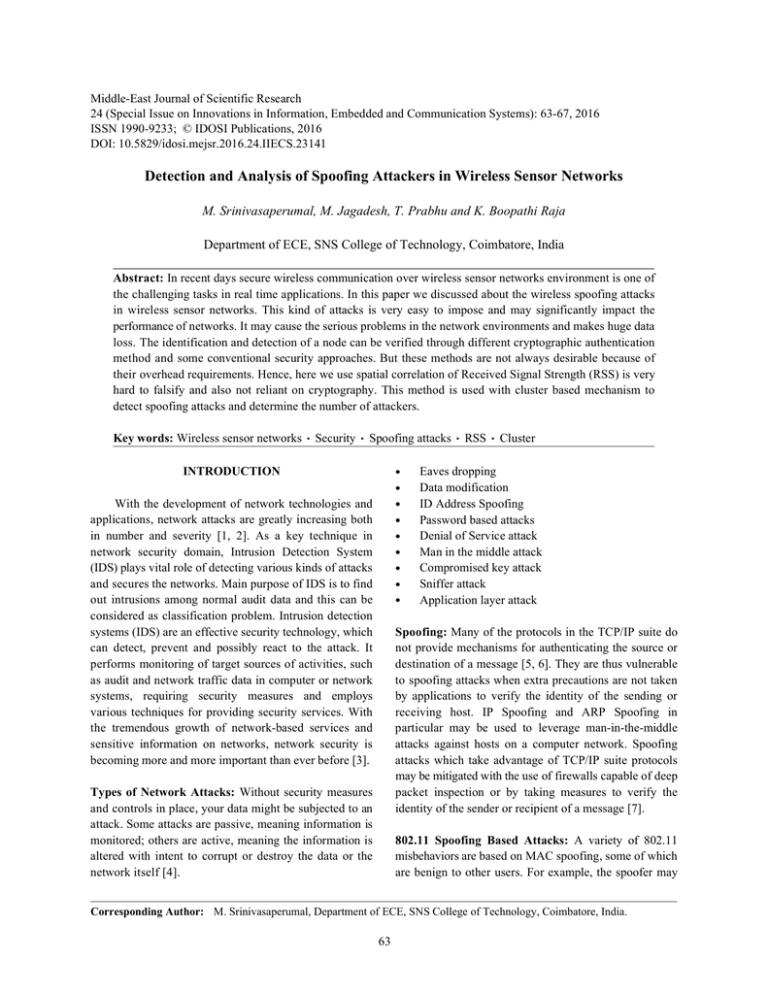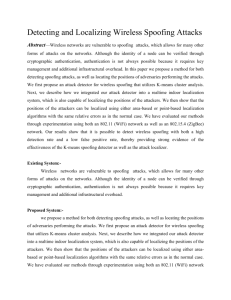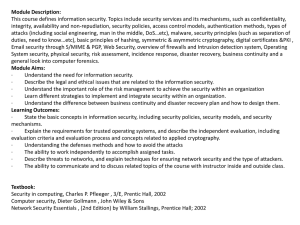Full Text
advertisement

Middle-East Journal of Scientific Research
24 (Special Issue on Innovations in Information, Embedded and Communication Systems): 63-67, 2016
ISSN 1990-9233; © IDOSI Publications, 2016
DOI: 10.5829/idosi.mejsr.2016.24.IIECS.23141
Detection and Analysis of Spoofing Attackers in Wireless Sensor Networks
M. Srinivasaperumal, M. Jagadesh, T. Prabhu and K. Boopathi Raja
Department of ECE, SNS College of Technology, Coimbatore, India
Abstract: In recent days secure wireless communication over wireless sensor networks environment is one of
the challenging tasks in real time applications. In this paper we discussed about the wireless spoofing attacks
in wireless sensor networks. This kind of attacks is very easy to impose and may significantly impact the
performance of networks. It may cause the serious problems in the network environments and makes huge data
loss. The identification and detection of a node can be verified through different cryptographic authentication
method and some conventional security approaches. But these methods are not always desirable because of
their overhead requirements. Hence, here we use spatial correlation of Received Signal Strength (RSS) is very
hard to falsify and also not reliant on cryptography. This method is used with cluster based mechanism to
detect spoofing attacks and determine the number of attackers.
Key words: Wireless sensor networks
Security
Spoofing attacks
INTRODUCTION
RSS
Cluster
Eaves dropping
Data modification
ID Address Spoofing
Password based attacks
Denial of Service attack
Man in the middle attack
Compromised key attack
Sniffer attack
Application layer attack
With the development of network technologies and
applications, network attacks are greatly increasing both
in number and severity [1, 2]. As a key technique in
network security domain, Intrusion Detection System
(IDS) plays vital role of detecting various kinds of attacks
and secures the networks. Main purpose of IDS is to find
out intrusions among normal audit data and this can be
considered as classification problem. Intrusion detection
systems (IDS) are an effective security technology, which
can detect, prevent and possibly react to the attack. It
performs monitoring of target sources of activities, such
as audit and network traffic data in computer or network
systems, requiring security measures and employs
various techniques for providing security services. With
the tremendous growth of network-based services and
sensitive information on networks, network security is
becoming more and more important than ever before [3].
Spoofing: Many of the protocols in the TCP/IP suite do
not provide mechanisms for authenticating the source or
destination of a message [5, 6]. They are thus vulnerable
to spoofing attacks when extra precautions are not taken
by applications to verify the identity of the sending or
receiving host. IP Spoofing and ARP Spoofing in
particular may be used to leverage man-in-the-middle
attacks against hosts on a computer network. Spoofing
attacks which take advantage of TCP/IP suite protocols
may be mitigated with the use of firewalls capable of deep
packet inspection or by taking measures to verify the
identity of the sender or recipient of a message [7].
Types of Network Attacks: Without security measures
and controls in place, your data might be subjected to an
attack. Some attacks are passive, meaning information is
monitored; others are active, meaning the information is
altered with intent to corrupt or destroy the data or the
network itself [4].
802.11 Spoofing Based Attacks: A variety of 802.11
misbehaviors are based on MAC spoofing, some of which
are benign to other users. For example, the spoofer may
Corresponding Author: M. Srinivasaperumal, Department of ECE, SNS College of Technology, Coimbatore, India.
63
Middle-East J. Sci. Res., 24(Special Issue on Innovations in Information, Embedded and Communication Systems): 63-67, 2016
want to use a randomly generated MAC address to hide
their presence, or to masquerade as an authorized MAC
address to circumvent AP’s MAC address access-control
list [8, 9]. Our focus, however, is on spoofing-based
denial-of service (DoS) attacks, misbehaviors that impact
other users by denying or degrading their network
services. The IEEE 802.11 standard requires a two-step
handshake before a wireless station (STA) can associate
with an AP. When an STA is associated with an AP, the
attacker can send a Deauthentication frame using the
forged MAC address of the AP. The STA becomes
disassociated and has to associate with the AP again. By
continuously sending such spoofed Deauthentication
frames, the attacker can break the wireless connectivity
between the STA and the AP. Note that the attacker may
also forge these frames using STA’s MAC address.
Since we are concerned with attackers who have different
locations than legitimate wireless nodes, utilizing spatial
information to address spoofing attacks has the unique
power to not only identify the presence of these attacks
but also localize adversaries. An added advantage of
employing spatial correlation to detect spoofing attacks
is that it will not require any additional cost or
modification to the wireless devices themselves.
GADE: GADE is Generalized Attack Detection modEl that
can both detect spoofing attacks as well as determine the
number of adversaries using cluster analysis methods
grounded on RSS-based spatial correlations among
normal devices and Adversaries. In GADE, The
Partitioning Around Medoids (PAM), cluster analysis
method is used to perform attack detection. We formulate
the problem of determining the number of attackers as a
multiclass detection problem and then applied clusterbased methods to determine the number of attacker.
A Generalized Attack Detection Model (GADE) that
can both detect spoofing attacks as well as determine the
number of adversaries using cluster analysis methods
grounded on RSS-based spatial correlations among
normal devices and adversaries. In this section, we
describe our Generalized Attack Detection ModEl. Which
consists of two phases: Attack detection, which detects
the presence of an attack and number determination,
which determines the number of adversaries.
In GADE, following two methods are used to perform
attacks and detections. They are Partitioning Around
Medoids (PAM) and cluster analysis method. The
problem of determining the number of attackers as a
multiclass detection problem and then applied clusterbased methods to determine the number of attacker.
Existing Methods: The existing method approaches to
address potential spoofing attacks employ cryptographic
schemes. Cryptography is an important and powerful tool
for
security
services,
namely
authentication,
confidentiality, integrity and non-repudiation [10]. It
converts readable data (plaintext) into meaningless data
(ciphertext). Cryptography has two dominant flavors,
namely symmetric-key (secret-key) and asymmetrickey
(public-key) approach. In symmetric-key cryptography,
the same key is used to encrypt and decrypt the
information, while in the asymmetric-key approach,
different keys are used to convert and recover the
information. Although the asymmetric cryptography
approach possesses versatileness (authentication,
integrity and confidentiality) and simplicity for key
distribution, symmetric-key algorithms are generally more
computation-efficient than the public-key approach. There
is a variety of symmetric or asymmetric algorithms
available, such as DES, AES, IDEA and RSA. Threshold
cryptography is a scheme quite different from the above
two approaches. In (k; n) secret sharing scheme, a secret
is split into n pieces according to a random polynomial.
The secret can be recovered by combining k pieces based
on Lagrange interpolation. These cryptography tools are
widely used in wired and wireless networks, obviously
they could also be used in mobile ad hoc networks [11].
Partitioning Around Medoids: A clustering Algorithm
that partitionates a dataset of n objects into a number k of
clusters and works trying to minimize the error. This
algorithm works with a matrix of dissimilarity, where its
goal is to minimize the overall dissimilarity between the
representants of each cluster and its members.The
Partitioning Around Medoids Method to perform
clustering analysis in RSS. The PAM Method is a popular
iterative descent clustering algorithm. Compared to the
popular K-means method the PAM method is more robust
in the presence of noise and outliers. Thus, the PAM
method is more suitable in determining clusters from RSS
streams, which can be unreliable and fluctuating over time
due to random noise and environmental bias.
Proposed Method: The proposed method involves the
use of received signal strength (RSS)-based spatial
correlation. It is a physical property associated with each
wireless node that is hard to falsify and not reliant on
cryptography as the basis for detecting spoofing attacks.
64
Middle-East J. Sci. Res., 24(Special Issue on Innovations in Information, Embedded and Communication Systems): 63-67, 2016
STEP 2
Select one of the nonmedoids O'
Let us assume O' = (7,3)
So now the medoids are c1(3,4) and O'(7,3)
Cluster the following data set of ten objects into two
clusters i.e. k = 2. Table 1, consider a data set of ten
objects as follows:
Table 1: Data set of ten objects
X1
X2
X3
X4
X5
X6
X7
X8
X9
X10
2
3
3
4
6
6
7
7
8
7
6
4
8
7
2
4
3
4
5
6
If c1 and O' are new medoids, calculate the total cost
involved. By using the formula in the step 1
Table 4: Cost from the Medoid (3,4)
I
1
3
4
5
6
7
9
10
STEP 1
Initialize k centers.
Let us assume c1 = (3,4) and c2 = (7,4)
So here c1 and c2 are selected as medoids.
Table 3: Cost from the Medoid (7,4)
I
c2
Data objects (Xi)
1
7
4
2
6
3
7
4
3
8
4
7
4
4
7
5
7
4
6
2
6
7
4
6
4
7
7
4
7
3
9
7
4
8
5
10
7
4
7
6
Then the clusters become:
Cluster1 = {(3,4)(2,6)(3,8)(4,7)}
Cluster2 = {(7,4)(6,2)(6,4)(7,3)(8,5)(7,6)}
Data objects (Xi)
4
4
4
4
4
4
4
4
2
3
4
6
6
7
8
7
6
8
7
2
4
4
5
6
Cost (distance)
3
4
4
5
3
4
6
4
Table 5: Cost from the Medoid(7,3)
Calculate distance so as to associate each data object
to its nearest medoid. Cost is calculated using Manhattan
distance. Costs to the nearest medoid are shown bold in
the Table 2 to 5.
Table 2: Cost from the Medoid (3,4)
I
c1
Data objects (Xi)
1
3
4
2
6
3
3
4
3
8
4
3
4
4
7
5
3
4
6
2
6
3
4
6
4
7
3
4
7
3
9
3
4
8
5
10
3
4
7
6
c1
3
3
3
3
3
3
3
3
I
1
3
4
5
6
7
9
10
Cost (distance)
3
4
4
5
3
5
6
6
O'
7
7
7
7
7
7
7
7
Data objects (Xi)
3
3
3
3
3
3
3
3
2
3
4
6
6
7
8
7
6
8
7
2
4
4
5
6
Cost (distance)
8
9
7
2
2
1
3
3
TOTAL COST= 3+4+4+2+2+1+3+3=22
So cost of swapping medoid from c2 to O' is
S=Current total cost-Past total cost=22-20=2>0
So moving to O' would be a bad idea, so the
previous choice was good. So we try other nonmedoids
and found that our first choice was the best. So the
configuration does not change and algorithm terminates
here (i.e. there is no change in the medoids). It may
happen some data points may shift from one cluster to
another cluster depending upon their closeness to
medoid. In some standard situations, k-medoids
demonstrate better performance than k-means. The most
time-consuming part of the k-medoids algorithm is the
calculation of the distances between objects. If a
quadratic preprocessing and storage is applicable, the
distances matrix can be precomputed to achieve
consequent speed-up. See for example, where the authors
also introduce a heuristic to choose the initial k medoids.
A comparative study of K-means and k-medoids
algorithms was performed for normal and for uniform
distributions of data points. It was demonstrated that in
the asymptotic of large data sets the k-medoids algorithm
takes less time.
Cost (distance)
7
8
6
3
1
1
2
2
Since the points (2,6) (3,8) and (4,7) are closer to c1
hence they form one cluster whilst remaining points from
another cluster. So the total cost involved is 20.Total cost
is the summation of the cost of data object from its
medoid in its cluster so here:
Totalcost={cost((3,4), (2,6)) + cost((3,4), (3,8)) +
cost((3,4), (4,7))} + {cost((7,4), (6,2)) + cost((7,4), (6,4)) +
cost((7,4), (7,3)) + cost((7,4), (8,5)) + cost((7,4), (7,6))}
65
Middle-East J. Sci. Res., 24(Special Issue on Innovations in Information, Embedded and Communication Systems): 63-67, 2016
Simulation Results:
The Fig. 3 explains the presence of a masquerade
node where the 11th node masquerade like the 10th node
with the ID of 10th node.
CONCLUSIONS
In this paper, we discussed about the received
signal strength based spatial correlation, a physical
property associated with each wireless device that is hard
to falsify and not reliant on cryptography as the basis for
detecting spoofing attacks in wireless networks. In future
process the next stage includes the detection of number
of attackers and localization of the attackers will be
processed with NS2 and improve the accuracy of
detecting the attackers in wireless sensor networks.
Fig. 1: Movement of Nodes from LM1
REFERENCES
The Fig. 1 shows the movement of nodes 10,11,13
and 14 from Land Mark LM1 to the Land Mark LM2.
1.
2.
3.
4.
Fig. 2: Transmission of Packets
The Fig. 2 shows the transmission of packets
between the nodes through the shortest path to the Base
Station when it reaches Land Mark LM1.
5.
6.
7.
8.
9.
Fig. 3: Detection of Spoofing Attacker
66
Bellardo, J. and S. Savage, 2003. 802.11 Denial-ofService Attacks: Real Vulnerabilities and Practical
Solutions, Proc. USENIX Security Symp., pp: 15-28.
Chen, Y., W. Trappe and R.P. Martin, 2007. Detecting
and Localizing Wireless Spoofing Attacks, Proc.
Ann. IEEE Comm. Soc. Conf. Sensor, Mesh and Ad
Hoc Comm. and Networks (SECON).
Faria, D. and D. Cheriton, 2006. Detecting IdentityBased Attacks in Wireless Networks Using
Signalprints,” Proc. ACM Workshop Wireless
Security (WiSe).
Ferreri, F., M. Bernaschi and L. Valcamonici, 2004.
Access Points Vulnerabilities to Dos Attacks in
802.11 Networks, Proc. IEEE Wireless Comm. and
Networking Conf.
Guo, F. and T. Chiueh, 2006. Sequence NumberBased MAC Address Spoof Detection, Proc. Eighth
Int’l Conf. Recent Advances in Intrusion Detection,
pp: 309-329.
Kaufman, L. and P.J. Rousseeuw, 1990. Finding
Groups in Data: An Introduction to Cluster Analysis.
Wiley Series in Probability and Statistics.
Young, M., 1989. The Technical Writer's Handbook.
Mill Valley, CA: University Science.
Sheng, Y., K. Tan, G. Chen, D. Kotz and A. Campbell,
2008. Detecting 802.11 MAC Layer Spoofing Using
Received Signal Strength, Proc. IEEE INFOCOM.
Wool, A., 2005. Lightweight Key Management for
IEEE 802.11 Wireless Lans With Key Refresh and
Host Revocation, ACM/Springer Wireless Networks,
11(6): 677-686.
Middle-East J. Sci. Res., 24(Special Issue on Innovations in Information, Embedded and Communication Systems): 63-67, 2016
10. Wu, B., J. Wu, E. Fernandez and S. Magliveras, 2005.
Secure and Efficient Key Management in Mobile Ad
Hoc Networks, Proc. IEEE Int’l Parallel and
Distributed Processing Symp. (IPDPS).
11. Yang, J., Y. Chen and W. Trappe, 2009. Detecting
Spoofing Attacks in Mobile Wireless Environments,
Proc. Ann. IEEE Comm. Soc. Conf. Sensor, Mesh and
Ad Hoc Comm. and Networks (SECON).
67




